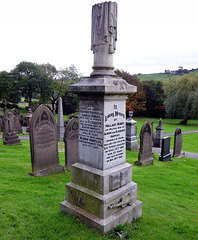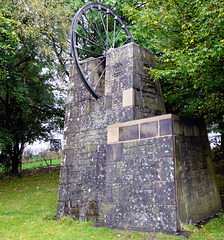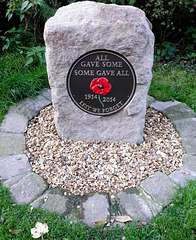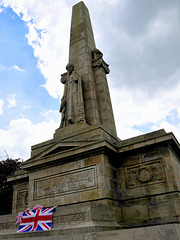Phil's photos with the keyword: Monument
Memorial. HFF
| 03 Apr 2020 |
|
|
|
The war memorial in the centre of Brierfield, North-West England, photographed a few years ago after the local "Remembrance Day" parade and ceremonies. HFF to all viewers....stay safe.
Camera: Sony RX100
Processed with Nikon Capture NX2
Alice Nutter 400th anniversary Memorial (1 of 2).
| 29 May 2013 |
|
|
|
Alice Nutter was one of the accused "Pendle Witches". She was executed at Lancaster with 9 others in 1612. This statue was commissioned to mark the 400th anniversary of the witch trials.
Camera: Nikon D300s. Lens: Nikkor 70-200mm f2.8
More information here:
en.wikipedia.org/wiki/Pendle_witches
"Panopticon atom" at Wycoller.
| 04 Mar 2015 |
|
|
|
The "Panopticon atom", situated on a hill-top above the village of Wycoller in Pendle District, Lancashire, in the North-West of England.
This Panopticon is an "arts and regeneration project" of the East Lancashire Environmental Arts Network. It involved the construction of a series of 21st-century landmarks or Panopticons (structures providing a comprehensive view) across East Lancashire, England, as symbols of the renaissance of the area. Four large-scale sculptures were commissioned, designed and constructed over a six year period for the districts of Blackburn, Burnley, Pendle and Rossendale. "The Halo" in Haslingden (Rossendale) was the last sculpture in the series to be erected in 2007".
VIDEOS here:
www.youtube.com/watch?v=xrCuBw-3Hns
www.youtube.com/watch?v=oTb-kR2BFU8
Industrial memorial.
| 29 Oct 2014 |
|
|
|
This giant-sized replica of a weaver's shuttle (known locally as "The Rusty Rocket") was erected in the centre of the town of Nelson in Lancashire, North-West England, during the recent town-centre re-developments. Nelson and the surrounding area was, until the mid-20th Century, at the centre of the textile industry in Britain but this has now virtually disappeared. Most local textile manufacturers have re-located to other parts of the world where labour is cheap and profits are high. Photographed with a HTC "Desire" smartphone and processed with Nikon Capture NX2.
"Millie" the Lancashire Mill-girl.
| 14 Oct 2014 |
|
|
|
A metal sculpture of a young Lancashire Mill-worker entitled "Millie", situated outside the railway station in Colne, North-West England. During the 18th, 19th and early-20th Centuries the textile industry (mostly weaving) provided employment for the majority of people in this part of the country but the industry has been steadily declining for many years and is now almost extinct. Most of the larger textile companies have relocated to the developing countries of the far-East where labour is cheap, profits are high and health & safety at work is "less of an issue".
Photographed with a Sony RX100 compact camera and processed with Nikon Capture NX2 software.
"By superstition & ignorance".
| 11 Oct 2014 |
|
|
|
A memorial situated near the entrance to Pendle Heritage Centre in Barrowford, Lancashire, in the North-West of England. In 1612 the Pendle Forest area was the setting for Britain's most famous / infamous "Witch trials" when 12 people (2 men and 10 women) were accused of various crimes allegedly committed by the use of "Witchcraft". One of the accused, an elderly woman, died in jail before the trial and one person was found not-guilty. The remaining 10 were all found guilty and hanged. The so-called "evidence" was based almost entirely on the testimony of Jennet Device, a 9-year-old child who was the "One voice for ten" inscribed on the monument. Between the time the accused (including all of Jennet's family) were arrested and the time they were brought to trial, Jennet is believed to have been in the care of Roger Nowell who "coincidentally" happened to be the prosecuting magistrate in the case and who almost certainly "coached" her in the evidence she would give.
MORE INFORMATION HERE:
en.wikipedia.org/wiki/Pendle_witches
www.visitlancashire.com/inspire-me/pendle-witches
Photographed with a Sony RX100 camera and processed with Nikon Capture NX2.
Wallace Hartley's grave (2 of 2).
| 09 Oct 2014 |
|
|
|
The grave of Wallace Hartley, the Bandmaster and Lead-Violinist on the RMS Titanic who lost his life in the disaster. He and all of the band members stayed at their post as the ship sank, playing (according to most reports) the hymn "Nearer my God To Thee").
Camera: Sony RX100.
Processed with Nikon Capture NX2.
After the Titanic hit an iceberg and began to sink, Hartley and his fellow band members started playing music to help keep the passengers calm as the crew loaded the lifeboats. Many of the survivors said that he and the band continued to play until the very end. None of the band members survived the sinking. One survivor claimed to have seen Hartley and his band standing on the boat deck near the entrance to the grand staircase, near the base of the second funnel. He went on to say that he saw three of them washed off while the other five held on to the railing on top the Grand Staircase's deckhouse, only to be dragged down with the bow, as Hartley exclaimed, "Gentlemen, I bid you farewell." A newspaper at the time reported "the part played by the orchestra on board the Titanic in her last dreadful moments will rank among the noblest in the annals of heroism at sea."
Hartley's body was recovered by the Mackay–Bennett almost two weeks after the sinking and several press reports confirmed that Wallace was found "fully dressed with his music case strapped to his body". He was transferred to the Arabic and returned to England. Wallace's father, Albion, met the ship at Liverpool and brought his son back to his home town of Colne, Lancashire. The funeral took place on 18th May 1912. One thousand people attended his funeral, while an estimated 30,000 - 40,000 lined the route of his funeral procession. Hartley is buried in the Keighley Road cemetery, Colne, where a 10 feet (3.0 m) high headstone containing a carved violin at its base was erected in his honour.
(Wikipedia).
Coal-mining monument.
| 07 Oct 2014 |
|
|
|
A monument / memorial to the coal-mining industry which was once widespread in this area. Photographed in Thompson Park, Burnley, in the North-West of England.
The Lancashire Coalfield in North West England was one of the most important British coalfields. It's seams were formed from the vegetation of tropical swampy forests in the Carboniferous period over 300 million years ago. The Romans may have been the first to use coal in Lancashire and it's shallow seams and outcrops were exploited on a small scale from the Middle Ages and extensively after the start of the Industrial Revolution. The coalfield was at the forefront of innovation in coal mining prompting the country's first canals, the use of steam engines and creating conditions favourable for rapid industrialisation. The pits on the coalfield were at their most productive in 1907 when more than 26 million tons of coal were produced. By 1967 just 21 collieries remained. Parkside Colliery in Newton-le-Willows, the last deep mine to be sunk on the coalfield, was closed in 1993.
(Wikipedia).
Camera: Sony RX100
Processed with Nikon Capture NX2.
In Memoriam.
| 04 Oct 2014 |
|
|
|
A monument photographed near the village of Roughlee in the district of Pendle, North-West England, erected recently to mark the 100th anniversary of the beginning of the First World War. Photographed with a Sony RX100 camera and processed with Nikon Capture NX2.
York, Constantine The Great.
| 30 Jan 2014 |
|
|
|
Constantine the Great (Flavius Valerius Aurelius Constantinus Augustus; 274 – 337), also known as Constantine I or Saint Constantine, was Roman Emperor from 306 to 337. Constantine was the son of Flavius Valerius Constantius, a Roman army officer and his consort Helena. His father became Caesar, the deputy emperor in the west in 293. Constantine was sent East where he rose through the ranks to become a military tribune under the emperors Diocletian and Galerius. In 305, Constantius was raised to the rank of Augustus, senior western emperor, and recalled West to campaign under his father in Britannia. Acclaimed as emperor by the army after his father's death in 306, Constantine emerged victorious in a series of civil wars against the emperors Maxentius and Licinius to become sole ruler of both west and east by 324.
The first Roman emperor to convert to Christianity, Constantine played an influential role in the proclamation of the Edict of Milan, which decreed religious tolerance throughout the empire. He called the First Council of Nicaea in 325, at which the Nicene Creed was professed by Christians. In military matters, the Roman army was reorganised to consist of mobile field units and garrison soldiers capable of countering internal threats and barbarian invasions. Constantine pursued successful campaigns against the tribes on the Roman frontiers—the Franks, the Alamanni, the Goths, and the Sarmatians—even resettling territories abandoned by his predecessors during the turmoil of the previous century. The age of Constantine marked a distinct epoch in the history of the Roman Empire.
(Wikipedia).
Dick Turpin's grave.
| 22 Nov 2013 |
|
|
|
Richard "Dick" Turpin (1705 – 1739) was an English highwayman whose exploits were romanticised following his execution in York for horse theft. Turpin may have followed his father's profession as a butcher early in life but by the early 1730s he had joined a gang of deer thieves and later became a poacher, burglar, horse thief and killer. He is also known for a fictional 200-mile (320 km) overnight ride from London to York on his horse Black Bess, a story that was made famous by the Victorian novelist William Harrison Ainsworth almost 100 years after Turpin's death.
Turpin's involvement in the crime for which he is most closely associated—highway robbery—followed the arrest of the other members of his gang in 1735. He then disappeared from public view towards the end of that year, only to resurface in 1737 with two new accomplices, one of whom he may have accidentally shot and killed. Turpin fled from the scene and shortly afterwards killed a man who attempted his capture. Later that year he moved to Yorkshire and assumed the alias of John Palmer.
While he was staying at a local inn magistrates became suspicious and made enquiries as to how he was funding his extravagant lifestyle. Suspected of being a horse thief, Turpin / "Palmer" was imprisoned in York Castle to await trial at the next assizes. Turpin's true identity was revealed by a letter he wrote to his brother-in-law from his prison cell which fell into the hands of the authorities. On 22nd March 1739 Turpin was found guilty on two charges of horse theft and sentenced to death. He was hanged at Knavesmire (located close to the present-day York racecourse and which was known locally as "The York Tyburn") on 7th April 1739.
(Wikipedia. (edited)).
Camera: Olympus AZ-1 (Low resolution).
Processing: Nikon Capture NX2.
Angel of the North.
| 25 Jun 2013 |
|
|
|
The Angel of the North is a contemporary sculpture designed by Antony Gormley, located in Gateshead, Tyne and Wear, England. It is a steel sculpture of an angel, 20 metres (66 ft) tall, with wings measuring 54 metres (177 ft) across and it weighs 200 tons. The wings do not stand straight sideways, but are angled 3.5 degrees forward; Gormley did this to create "a sense of embrace".
It stands on a hill on the southern edge of Low Fell, overlooking the A1 and A167 roads into Tyneside and the East Coast Mainline rail route.
(Wikipedia).
More information here:
en.wikipedia.org/wiki/Angel_of_the_North
Oak Hill Memorial.
| 08 Jun 2013 |
|
|
|
Memorial to the men of Accrington, UK, who were lost in WW1. Photographed in Oak Hill park.
Jump to top
RSS feed- Phil's latest photos with "Monument" - Photos
- ipernity © 2007-2025
- Help & Contact
|
Club news
|
About ipernity
|
History |
ipernity Club & Prices |
Guide of good conduct
Donate | Group guidelines | Privacy policy | Terms of use | Statutes | In memoria -
Facebook
Twitter













